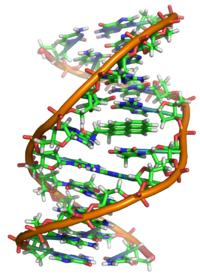
Photo from wikipedia
The exposure of human DNA to genotoxic compounds induces the formation of covalent DNA adducts, which may contribute to the initiation of carcinogenesis. Liquid chromatography (LC) coupled with high-resolution mass… Click to show full abstract
The exposure of human DNA to genotoxic compounds induces the formation of covalent DNA adducts, which may contribute to the initiation of carcinogenesis. Liquid chromatography (LC) coupled with high-resolution mass spectrometry (HRMS) is a powerful tool for DNA adductomics, a new research field aiming at screening known and unknown DNA adducts in biological samples. The lack of databases and bioinformatics tool in this field limits the applicability of DNA adductomics. Establishing a comprehensive database will make the identification process faster and more efficient and will provide new insight into the occurrence of DNA modification from a wide range of genotoxicants. In this paper, we present a four-step approach used to compile and curate a database for the annotation of DNA adducts in biological samples. The first step included a literature search, selecting only DNA adducts that were unequivocally identified by either comparison with reference standards or with nuclear magnetic resonance (NMR), and tentatively identified by tandem HRMS/MS. The second step consisted in harmonizing structures, molecular formulas, and names, for building a systematic database of 279 DNA adducts. The source, the study design and the technique used for DNA adduct identification were reported. The third step consisted in implementing the database with 303 new potential DNA adducts coming from different combinations of genotoxicants with nucleobases, and reporting monoisotopic masses, chemical formulas, .cdxml files, .mol files, SMILES, InChI, InChIKey and IUPAC nomenclature. In the fourth step, a preliminary spectral library was built by acquiring experimental MS/MS spectra of 15 reference standards, generating in silico MS/MS fragments for all the adducts, and reporting both experimental and predicted fragments into interactive web datatables. The database, including 582 entries, is publicly available (https://gitlab.com/nexs-metabolomics/projects/dna_adductomics_database). This database is a powerful tool for the annotation of DNA adducts measured in (HR)MS. The inclusion of metadata indicating the source of DNA adducts, the study design and technique used, allows for prioritization of the DNA adducts of interests and/or to enhance the annotation confidence. DNA adducts identification can be further improved by integrating the present database with the generation of authentic MS/MS spectra, and with user-friendly bioinformatics tools.
Journal Title: Frontiers in Chemistry
Year Published: 2022
Link to full text (if available)
Share on Social Media: Sign Up to like & get
recommendations!